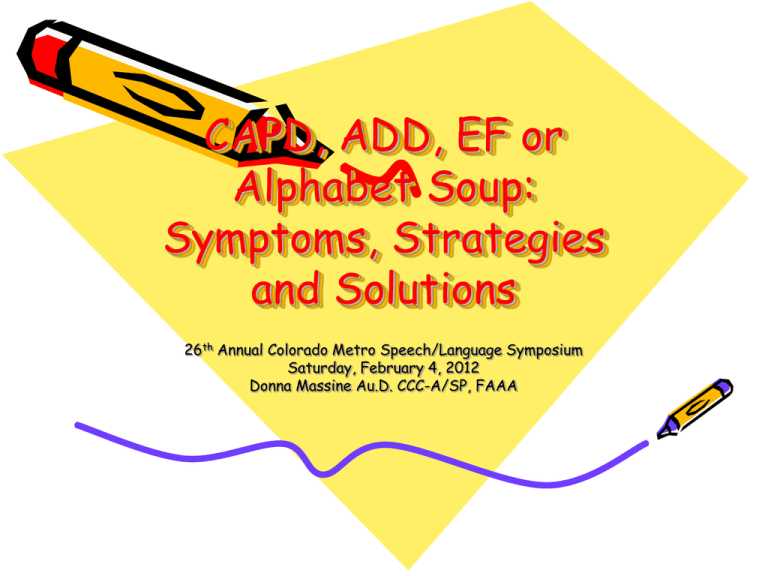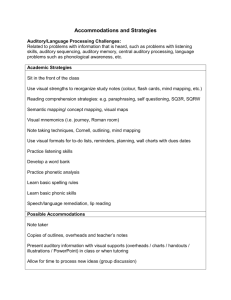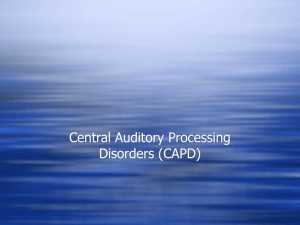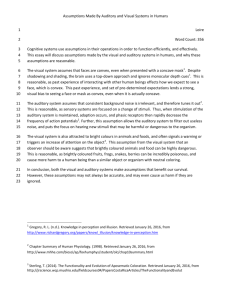handout
advertisement

CAPD, ADD, EF or Alphabet Soup: Symptoms, Strategies and Solutions 26th Annual Colorado Metro Speech/Language Symposium Saturday, February 4, 2012 Donna Massine Au.D. CCC-A/SP, FAAA Plan • • • • • • • Auditory Processing Theories-Past & Present CDE-CAPD Guidelines 2008 Defining A P and EF Symptoms ADHD and CAPD CSI(Child Scene Investigation) Putting it all together: CAPD, ADD and EF Sharpening observation tools to inform instruction- Ecological Assessment • Applying Brain Based Research to CSI • Intervention- CSI Returns (Child Scene Intervention)- Interventions at the level of the Scene (environment) and at the level of the child • More on CDE- CAPD Guidelines • Suggestions for clinicians Auditory Processing Theories: Past and Present Auditory Processing Deficits are Implicated in Multiple Disorders - Most often invoked in theories about three disorders: Auditory Processing Disorders (APD), Specific Language Impairment (SLI) and dyslexia (Miller, LSHSS July 2011) - ASHA definition 2005 inappropriate to apply APD to children with language impairment or learning disability unless a comorbid deficit can be demonstrated History of Auditory Processing Research • Audiological Approach originated from the study of brain lesions (1970’s) • Psychoeducational Approach auditory perceptual skills • Language processing Approach interactive nature between speech and language processing (top down influences bottom up) Controversies about APD: • Modality specificity – Auditory! Need to assess processing of other modalities • Linguistic vs. non-linguistic components • APD role in Language processingcause or consequence? • Other factors influence processing response in behavioral testing such as attention, motivation, memory, and speech ability Controversies about APD • Concerns about the reliability and validity of APD tests (Kahmi, LHSS July 2011)- test standardization and specificity- false negatives • Need additional tests (spatial listening) • High co-morbidity likely reflects the influence of attention, memory and language abilities on APD (Kahmi, LSHSS July 2011) Controversies about APD • APD subtypes – Purdy n=90 7-13 subtyping not possible (cluster analysis) • source of the deficit (APD) needs to be identified and acknowledged as there is not enough good research to determine which position has more validity Wallach (2011) and Medwetsky (2011) (Richard, LSHSS July 2011) CDE-CAPD Guidelines 2008 CDE-CAPD Guidelines 2008 Neuroscience • Researchers from all three strands have begun to turn to neurophysiological techniques • Need to develop a comprehensive theory of auditory processing • Neurophysiological Techniques • Event-related potentials or evoked potentials (ERP) obtained through Electro-encephalography by measuring the electrical activity of the brain • Functional MRI (fMRI) examines brain morphology Neuroscience: Brain Development R-L, B-F Normal Impaired Trained (formerly impaired) Temple, Poldrack, Gabrieli, et al., PNAS Defining AP and EF • What is “auditory processing”? • What the brain does with what the ear hears? • What are “executive functions?” • Control of self, others and planning Processing and Executive Function • Processing • • • • • • • • Perception Attention Language processes Visual spatial processes Sensory Inputs Motor outputs Memory Knowledge/skills • Executive Functions • • • • Inhibit Cognitive flexibility Initiate Working memory (hold and manipulate) • Plan • Organize • Self monitor/evaluate Memory • (Short Term Memory (sensory and immediate memory) • Working Memory • Long Term Memory (declarative and non-declarative memory) Learning and retention are different ( can learn for a few minutes but not retain it) ADHD, CAPD or………??? • Rank order ADHD – – – – – – inattentive distracted hyperactive fidgety/restless hasty/impulsive interrupts/intrudes – Differential Diagnosis – (Chermak, et. al. 1998) • Rank order CAPD – difficulty hearing in background noise – difficulty following oral directions – poor listening skills – academic difficulties – poor auditory assoc. – distracted – inattentive Ecological Assessment: Informal Probes/Observation • Behavioral observation during formal testing • Classroom Performance Impact Questionnaire (CPIQ) • Classroom observations: parent/teacher reports of concerns • Identify specific behaviors that are a problem…the symptoms are the symptoms CPIQ • • • • • • • • • • • Classroom Concerns (overall perspective) Oral language/listening Sustained attention (aud/visual) Working memory (order, aud/visual) Thinking/reasoning Reading, Writing and Math Task Initiation Organization Time management Metacognition Emotional Regulation CSI Investigating the Child and the Learning Scene • Compare referred student with typical student • Observe the student in an array of scenes: large group,small group and independent work Look for what’s working and what’s not Observation Checklists and other Informal Assessment Applying Brain Based Research to CSI • Retrieval = recognition (match outside info) or recall (with hints goes into LTM retrieve/decode in WM (retrieval depends on adequate cues, context of retrieval and mood of retrieval • Rate of learning impacted by motivation, emotional mood, degree of focus and context that learning occurs in Brain Based Research and CSI (intervention) • Limit number of items (WM Capacity) • Make information meaningful (model, use prime time, avoid controversial issues, create artificial meaning/mnemonics • Use motivation to increase process time Brain Based Research and CSI • Length of Instruction: Shorter is Better (20 minutes) • Prime Time-1 (9 min), Down Time (2 min), Prime Time-2 (9 min) • Amount of Down time increases with longer chunks (e.g. 10 min. in a 30 min block) • Teachers who call on fast processors signal slow processors to stop the retrieval process- lowers self concept and missed opportunity to relearn Brain Based Research and CSI • Use chunking to aid processing and retention (pattern, categorical and cumulative) • Using Rehearsal Strategies • Using primacy-recency effect • Using wait time to increase student participation/promote processing Windows of Opportunity as a child’s brain matures MUSIC MATH/LOG VOCAB EMOTION MOTOR 0 5 10 15 Changes in Capacity of Working Memory with Age Keep the number of items in a lesson objective within the capacity limits of students and they re likely to remember more of what they learned. Approximate age range in years Younger than five Between 5 &14 14 & older Capacity of working memory in number of chunks Minimum Maximum Average 1 3 2 3 7 5 5 9 7 The relationship of sense to meaning IS M E A N I N G Yes No Moderate to high Very low No Very high Moderate to high Yes Is Sense Present? P R E S E N T ? AVERAGE RETENTION RATE AFTER 24 HOURS VERBAL PROCESSING LECTURE 5% READING AUDIOVISUAL VERBAL &VISUAL PROCESSING DEMONSTRATION DISCUSSION GROUP 10% 20% 30% 50% PRACTICE BY DOING 75% DOING TEACH OTHERS / IMMEDIATE LEARNING USE 90% CSI Returns: Child-Scene-Intervention • At the level of the Environment Presentation Accommodations • At the level of the Student • Metacognition and Compensatory Strategies CSI: Enhancing Auditory Access for School Age Learners • • • • • • • • • • Questioning and Clarifying announce topic changes and purpose of lessons encourage students to use repair strategies ask open ended questions build from the known give enough “wait time” for-wait for 8-9 hands to go up for short answers-allow for multiple repetitions determine which approach is most successful (repeating or rephrasing) pause between phrases use sabotage technique to assist with clarification minimize “learned helplessness”- promote auditory rehearsal CSI:Enhancing Auditory Access for School Age Learners • • • • • • • • Communication/Presentation to the Class minimize walking and talking use visuals (graphic organizers, outlines) cue the students by addressing all class members when they are speaking sequence directions chronologically/present them one at a time avoid speaking while facing away minimize noise and time in transitions (use timer, flashing light to cue) wait for class to be quiet before beginning-develop a silent signal to promote class awareness of importance of quiet use pre-teach/ teach/ re-teach approach when needed CSI: Enhancing Auditory Access for School Age Learners Background Noise Kid’s don’t hear like short adults-use ALD technology-windows/doors closed Assess value of background music for independent work times •use “Yacker Tracker” or traffic light poster to identify expectation for noise level (quiet, whisper, regular voices) CSI:Visual Teaching Strategies • Graphic Organizers • Visual representations • Link background knowledgeeasier to remember than expanded text • Hierarchical Patterns: • Conceptual Patterns: • Sequential Patterns: • Cyclical Patterns: • Color Coding: organization • Icons: symbol, picture associations: • Story Grammar Marker: Glove, Braidy or SGM tool CSI:Visual Teaching Strategies • General Visual Teaching Techniques • Choose visuals that are developmentally appropriate/easy to recognize • Use a variety (combination of words and graphics best choice) • Job and Choice Menus • Classroom Rules Chart • Task organizers (list steps/completion) • Daily schedules • Internet (library of pictures, graphics, photos and videos) • Props for younger students • Transition Time cards/charts CSI: Teaching All Kids to be Better Self-Advocates • Identify obstacles for self-advocacy (student,environment, teacher and other factors) • Evaluate baseline for self-advocacyteacher/student input • Awareness of Learning Style (kinesthetic, visual, auditory) • Awareness of Level of Knowledge (know well, know somewhat, barely know) CSI: Self Advocacy • Keys to self-advocacy (acknowledgement, assertiveness, communication exchange) • Awareness of communication style (passive/timid, aggressive/bossy, assertive/self-confident) • Teach Communication Repair Strategies (repetition, revision, simple addition, clarifying addtion, nonverbal) CSI: Communication Repair Strategies • • • • Repetition (no new info) ) Revision (meaning unchanged) Simple Addition (new info)- increases thru age 9 Clarifying Addition (specific new info) • Inappropriate responses decrease until rare age 7, non existent after age 9) • Taken from SCRIPT. Building Skills for Success in the Fast-Paced Classroom. Karen Anderson. 2011 Percentage of Use of Communication Repair Strategy Types by Age from K. Anderson Age 9-11 Repetition Revision Age 9 Simple Add Age 7 Clarify Add Inapprop Age 5 Age 3 0 50 100 From K. Anderson Building Skills for Success in the Fast-Paced Classroom Commication Repair for Students Repetition Addition Revision Repetition 1. Slowly 2. Clearly 3. Louder 4. Key Wds Revision 5. Two Sentences 6. Different Wds 7. Different Form Addition 8. Simple addition 9. Define terms 10. Backgroun context Nonverbal Sign/spell, Show/Express, Write/Draw CSI:All Learners Need to be Self Advocates • Develop vocabulary to use when asking questions (includes awareness knowledge) • Apply prior knowledge to question • Identify reason for confusion, breakdown • Discussion of self-advocacy as a social skill -highlight when and how clarification should be used “Kids are not like tube socks…one size does not fit all.” Using Story Books to Promote Self Advocacy and Listening Skills • Self-Advocacy • A Case of Bad Stripes • Stand Tall Molly Lou Melon • Odd Velvet • Today Was a Terrible Day • I Like Me • What If the Teacher Calls on Me • I Like Myself • • • • • • • • Listening Listen Buddy Mr. Mumble Bendomelena the cat with a pot on her head The Hungry Thing Polar Bear Polar Bear What Do You Hear? The Listening Walk Things I Can Do CDE-APD Guidelines 2008 CDE-APD Guidelines 2008 CDE-APD Guidelines 2008 Preschoolers As Listeners (PAL) Listening Continuum (STAR) Self Taught Advocacy and Responsibility Turn taking ( my turn to talk your turn to listen) Body basics (Help develop good listening posture body alertness) Asking questions 1.(Where?Who?What?)2. Asking questions (when? Why? How?) Develop vocabulary for keywords for sequencing/organizing, (first next last) and emotions. Develop awareness of understanding “hunh” PAL Develop self awareness, self esteem( help parents and caregivers recognize strengths and learning styles) Develop awareness of environment/speaker impact ( too much, too noisy, too fast, too far) Develop self awareness of learning styles (vis/aud/kin) Develop awareness of known/unknown Develop awareness of communication breakdown STAR Develop compensatory strategies (organization, note taking, key words, skimming) Suggestions for Clinicians Wallach LSHSS July 2011 • Keep auditory weaknesses identified in alternative settings in perspective • Understand what language skills and strategies underlie the academic tasks • Keep contextualized (facial expression) and decontextualized aspects of language clearly defined –understand role of contextualized language in spoken/written language development • Read the research on the efficacy of auditory intervention in improving auditory, language andacademic outcomes (Fey, 2011) (Gillam, 2008) Suggestions for Clinicians • Evaluate the curricular/instructional demands over the grades • Consider the metalinguistic aspects of language learning • Develop language initiatives that focuses on the content-area subjects • Focus on intervention strategies that help students derive meaning from spoken/written text or metacognitive awareness Suggestions for Improving Auditory Processing in the Classroom Child Develop skills and use strengths, connections, interests * see intervention Scene Signal enhancement environmental modifications Visual supports/schedules Investigation/Intervention Observe child in authentic learning environment- identify obstacles/symptoms – adjust! Design a program that includes: Developing attending/listening skills- teacher and peers in class (eye contact) • • Developing rehearsal strategies- words, directions, stories using inner voice, chunking, visualization, note taking • Developing Active Listening skills- formulate appropriate comments, avoid redundancy • Developing Self Advocacy skills -recognize confusing information, seek clarification, repair. • Developing Coping with listening obstacles (noise)identify and solve noise problems, tuning out noise References • Anderson, K. Arnoldi, K. (2011) Building Skills for Success in the Fast-Paced Classroom. OR: Butte Publications. • Burns, M. (2009) Neurologically Speaking. Colorado Speech Language Hearing Conference. • Dawson,P. Guare,R. (2004) Executive Skills in Children and Adolescents: A Practical Guide to Assessment& Intervention. NY: Guilford Press.. • Dise-Lewis, J. (2007) Executive Functions: Developmental Conditions. Courage to Risk Conference, CO. References Dise-Lewis, J. (2007) Impact of Executive Function on Academic Performance. Speech Language Metro Symposium, CO. • Fey,M. et. al. (2011).Auditory Processing Disorder and Auditory/Language Interventions: An Evidence-Based Systematic Review. Language, Speech and Hearing Services in Schools. 42. 246264. • Gillam,R., et. al. (2008). The efficacy of Fast Forward Language Intervention in school-age children with language impairment: A randomized controlled trial. Journal of Speech, Language and Hearing Research, 51. 97-120 References • Isquith, P. (2008) Executive Function Concepts,Assessments and Intervention. CO:Courage to Risk Conference. • Janusz,J. Conjunction, Junction: What’s Executive Function? CO:CSHA Fall Conference • Kahmi, A. (2011) What Speech-Language Pathologists Need to Know About Auditory Processing Disorder. Language, Speech and Hearing Services in Schools. 42. 265-272. References • Meltzer,L. (2007) Executive Function in Education:From Theory to Practice. NY: Guilford Press. • Miller, C. (2011) Auditory Processing Theories of Language Disorders: Past, Present and Future. Language, Speech and Hearing Services in Schools. 42. 309-319. • Purdy, S. (2010) Diagnosis and treatment for APD: Current status and unanswered questions. Presentation. C.U. Boulder. References • Sousa, D. (2006). How the Brain Learns. CA: Corwin Press • Richard, G. (2011) The Role of the Speech-Language Pathologist in Identifying and Treating Children with Auditory Processing Disorder. Language, Speech and Hearing Services in Schools. 42. 297-302. • Wallach, G. (2011) Peeling the Onion of Auditory Processing Disorder: A Language/Curricular-Based Perspective. Language, Speech and Hearing Services in Schools. 42. 273285. References • Colorado Department of EducationAuditory Processing Deficits: A Team Approach to Screening, Assessment and Intervention Practices 2008. http://www.cde.state.co.us/cdesped/downl oad/pdf/APDGuidelines2008.pdf Notes Notes: Notes:





![to Learning Styles Questionnaire [MS Word,93Kb]](http://s3.studylib.net/store/data/007287401_2-741c6340dee171d22423967f2d0c2716-300x300.png)


